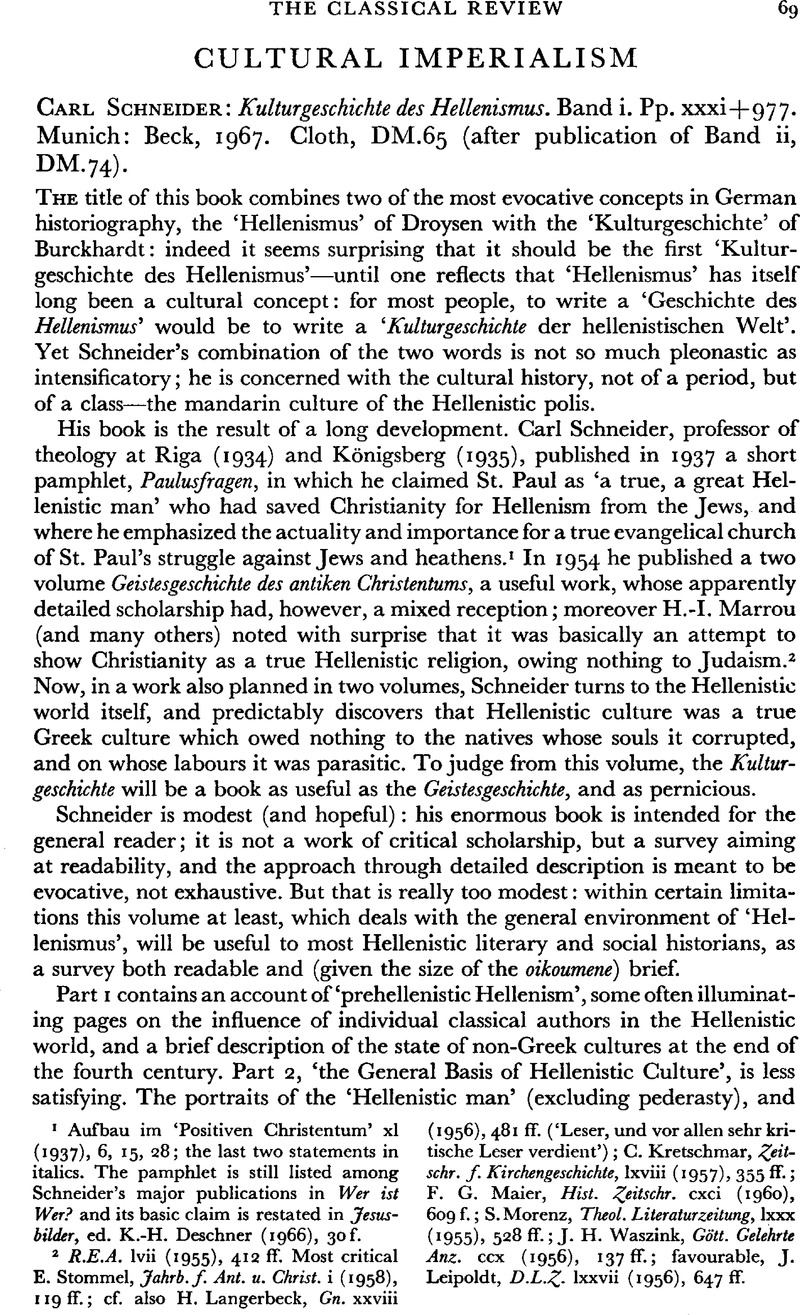Published online by Cambridge University Press: 27 February 2009

page 69 note 1 Aufbau im ‘Positiven Christentum’ xl (1937), 6, 15, 28Google Scholar; the last two statements in italics. The pamphlet is still listed among Schneider's major publications in Wer ist Wer? and its basic claim is restated in Jesusbilder, ed. K.-H. Deschner (1966), 30 f.
page 69 note 2 R.E.A. lvii (1955), 412 ffGoogle Scholar. Most critical Stommel, E., Jahrb.f. Ant. u. Christ. i (1958), 119 ff.Google Scholar; cf. also Langerbeck, H., Gn. xxviii (1956), 481 ffGoogle Scholar. (‘Leser, und vor alien sehr kritische Leser verdient’); Kretschmar, C., Zeitschr. f. Kirchengeschichte, lxviii (1957), 355 ff.Google Scholar; Maier, F. G., Hist. Zeitschr. cxci (1960), 609 f.Google Scholar; Morenz, S., Theol. Literaturzeitung, lxxx (1955), 528 ff.Google Scholar; Waszink, J. H., Gött. Gelehrte Anz. ccx (1956), 137 ff.Google Scholar; Favourable, Leipoldt, J., D.L.Z. lxxvii (1956), 647 ff.Google Scholar
page 70 note 1 Which omits any reference to Ehrenberg's Hellenistic State; sometimes Schneider does forget the most obvious work of all, as C. Préaux, L'Économie royale des Lagides, or E. Bickerman, Institutions des Séleucides.
page 70 note 2 As usual Schneider overestimates Greek influence, and his archaeological references are selective. Good brief descriptions, Arkell, A. J., A History of the Sudan 2 (1961), c. 7Google Scholar; Shinnie, P. L., Meroe (1967)Google Scholar; bibliography, Gadallah, F. F., Kush, xi (1963), 196 ffGoogle Scholar. Except during the reign of Ergamenes (c. 250–215, not 200: Haycock, B. G., Kush, xiii (1965), 264 ff.Google Scholar), religiously Kush was under the control of the priests of Amun-Re, and politically it was often hostile, and may even have supported rebels in the Thebaid: Alliot, M., Rev. Beige de Phil, et d'Hist. xxix (1951) 421 ff.CrossRefGoogle Scholar; Barguet, P., La Stèle de la Famine à Séhel (1953), 34 ff.Google Scholar; Pestman, P. W., Chr. d'Ég. xl (1965), 157 ff.Google Scholar
page 70 note 3 On Hellenistic accounts of India, cf. also Dihle, A., R.M. cv (1962), 97 ff.Google Scholar; P.C.P.S. x (1964), 15 fF.; on Asoka, G. Pugliese Caratelli and others, A Bilingual Graeco-Aramic Edict by Asoka (1964).
page 70 note 4 The new excavations are better used in Webster, T. B. L., Hellenistic Poetry and Art, (1964), 22 ff.Google Scholar
page 71 note 1 Contrast, for instance, the illuminating sketch of Otto, W., Kulturgeschichte des Altertums (1925), 93 ffGoogle Scholar. On this aspect of the legacy of Droysen see esp. Préaux, C., Chr. d'Ég. xl (1965), 129 ff.Google Scholar
page 71 note 2 Eos, xlviii. 3 (1956), 169 ff.Google Scholar
page 71 note 3 Hellenistic Civilization and the Jews (E. T. 1959), 358 ff.
page 71 note 4 J.T.S. xvii (1967), 342 n. 4.Google Scholar
page 72 note 1 ‘Die grosse Verwandlung des Hellenentums aus einer politischen in eine Kulturpotenz’: Griechische Kulturgeschichte, iv3 (1902), 348 = 1957 ed., p. 326.
page 72 note 2 Cf. also Bengtson, H., P.d.P. xi (1956), 170 ffGoogle Scholar. = Welt als Geschichte, xviii (1958), 7 ff.; J. Vogt, Sklaverer und Humanität (1965), 20 ff.
page 72 note 3 The King is Dead (1961).
page 72 note 4 Cf. Ranowitsch, A. B., Der Hellenismus und seine geschichtliche Rolle, tr. Diesing, K. (1958).Google Scholar